Overview
This article delves into the advantages and challenges of engaging a user experience (UX) design agency compared to maintaining in-house design teams for Software as a Service (SaaS) companies. It asserts that agencies bring specialized expertise and scalability to the table. However, in-house teams excel in fostering brand alignment and facilitating quicker communication. Ultimately, the decision hinges on the specific needs of the project and the long-term objectives of the organization.
Introduction
In the competitive landscape of user experience design, SaaS companies find themselves at a crossroads: should they leverage an external agency or cultivate an in-house team? Each approach presents unique advantages and challenges that can profoundly influence user satisfaction and retention.
As organizations grapple with this pivotal decision, it is imperative to grasp the nuances of both options.
What critical factors must be evaluated to ascertain the best fit for a company's distinct needs?
Moreover, how can businesses optimize their user experience strategies in an increasingly cutthroat market?
Understanding these elements is essential for any organization aiming to thrive.
Understanding User Experience Design
The user experience design agency is pivotal in enhancing satisfaction by improving usability, accessibility, and the overall enjoyment of interactions between individuals and products. It encompasses various components, including visual aesthetics, interaction structures, and information architecture. Effective creation by a user experience design agency is inherently centered around individuals, focusing on understanding their needs and behaviors to develop intuitive and engaging experiences.
In the realm of SaaS offerings, where client retention and satisfaction are paramount, a well-executed strategy from a user experience design agency can profoundly influence overall success and profitability. For instance, organizations leveraging scalable SaaS infrastructure have reported 28% fewer performance-related complaints compared to those using static systems, underscoring the impact of effective UX on operational efficiency.
Furthermore, expert insights emphasize that investing in a user experience design agency for user-focused development is not merely a luxury but a necessity for SaaS companies striving to thrive in a competitive market. Effective UX strategies, developed by a user experience design agency, such as streamlining onboarding processes and incorporating personalized features, have shown significant improvements in satisfaction and retention.
By prioritizing these architectural principles, a user experience design agency can help SaaS platforms foster stronger relationships with clients, ultimately enhancing loyalty and achieving sustained success. Continuous optimization based on user feedback is essential for maintaining relevance and engagement, while trends like passwordless authentication and a focus on accessibility are increasingly vital for a user experience design agency in modern UX practices.
However, implementing effective UX development strategies can pose challenges that necessitate careful consideration and resource allocation.
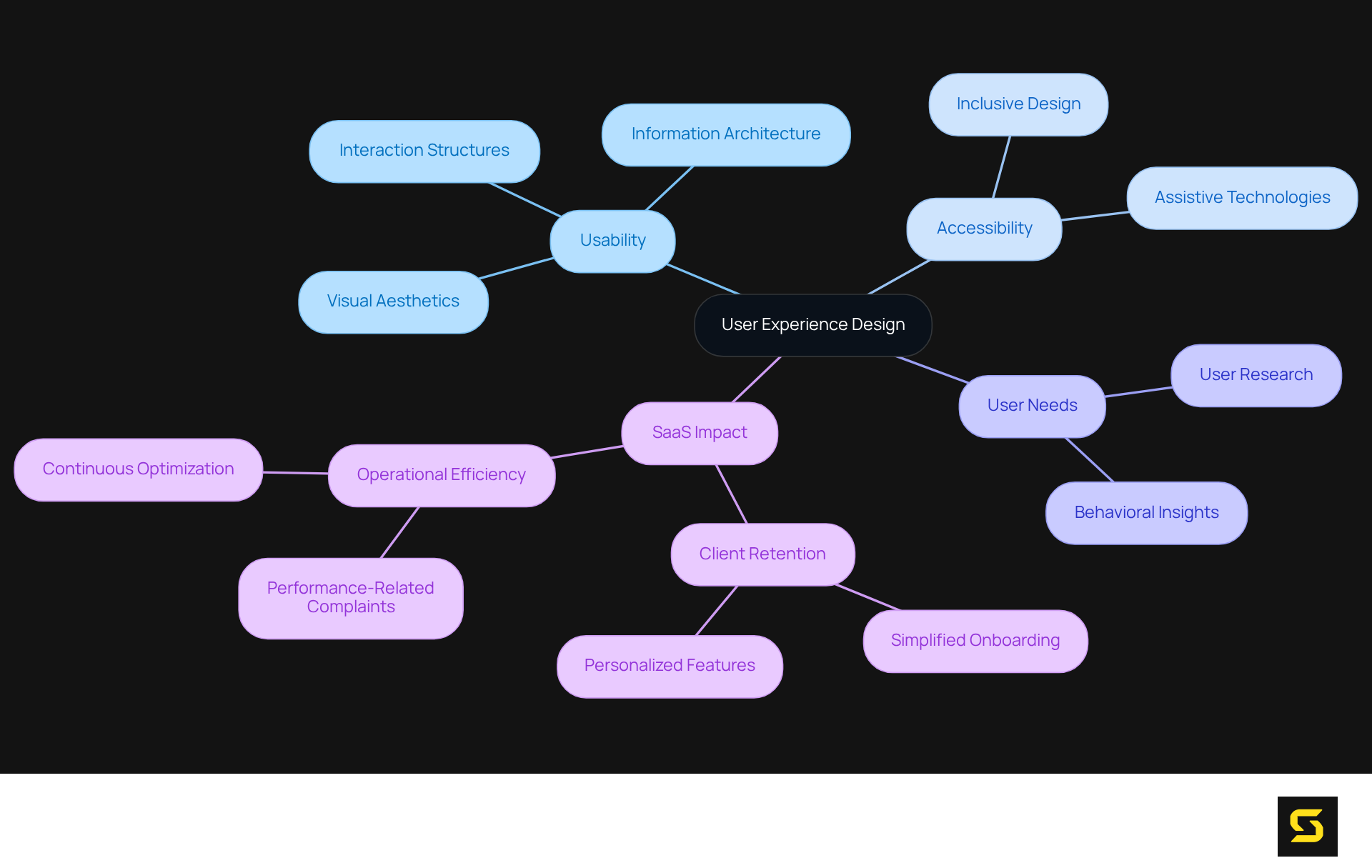
Advantages of Engaging a UX Design Agency
Collaborating with a UX development agency presents significant advantages for SaaS companies eager to drive innovation swiftly and effectively. These agencies typically comprise diverse teams of specialists, each bringing substantial experience from various sectors. This diversity not only introduces fresh perspectives but also fosters creative solutions that internal teams might overlook due to their familiarity with established processes. Furthermore, agencies offer scalability, adjusting their resources to meet project demands, which is particularly advantageous for startups or businesses with fluctuating workloads. This adaptability guarantees that projects are executed efficiently, free from the limitations often encountered by in-house teams.
Moreover, a user experience design agency leverages cutting-edge development tools and methodologies, ensuring their outputs align with the latest industry standards and trends. For instance, a well-designed user interface can boost conversion rates by as much as 200%, underscoring the tangible benefits of investing in expert creative services. This commitment to innovation not only elevates the quality of the deliverables but also empowers companies to maintain a competitive edge in a rapidly evolving market. By outsourcing UX development, organizations can concentrate their internal resources on core business functions, thereby enhancing overall operational efficiency. However, it is crucial to remain cognizant of potential challenges such as timezone differences, language barriers, and risks associated with intellectual property and data security. Ultimately, this strategic investment in external expertise can lead to substantial improvements in user experience, driving higher acquisition and retention rates.
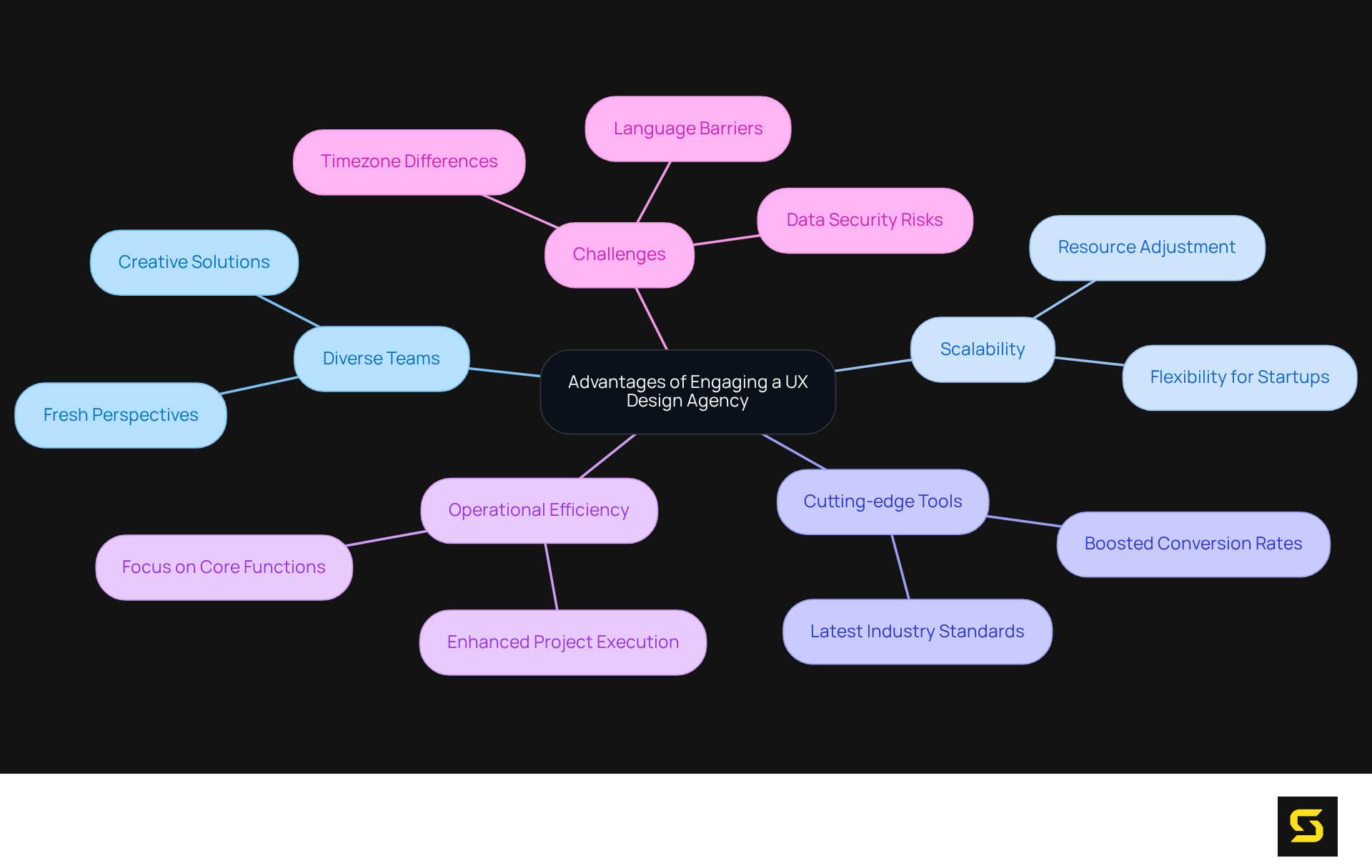
Challenges of Collaborating with a UX Design Agency
Collaborating with a UX firm presents numerous benefits, yet it is essential to acknowledge the challenges that may arise during such partnerships. A significant concern is the potential for miscommunication; organizations may struggle to grasp the firm’s culture, values, or specific user needs. This disconnect can result in designs that fail to align with the organization’s vision. Additionally, with firms often managing multiple clients, split focus can lead to delayed response times. Budget constraints further complicate matters, as organizations may face higher initial costs compared to maintaining an internal team. Statistics reveal that:
- 39% of organizations experience inefficiencies stemming from unclear project goals, ultimately increasing costs and extending timelines.
- 30% of organizations report that ambiguous client expectations elevate project expenses, exacerbating financial challenges.
The iterative feedback process can also be prolonged, as organizations must coordinate meetings and discussions, potentially pushing project timelines back.
Experts assert that ineffective communication may signal deeper trust issues between organizations and clients, jeopardizing relationships. A survey shows that:
- 98% of agencies and clients agree that trust is vital for sustaining successful partnerships; however, miscommunication frequently undermines this trust.
- Companies with over 100,000 employees incur an average cost of $62.4 million annually due to poor communication, highlighting the broader financial repercussions of these challenges.
Addressing miscommunication is crucial for fostering effective collaboration and ensuring that final creations resonate with the intended audience, thereby enhancing the overall experience.
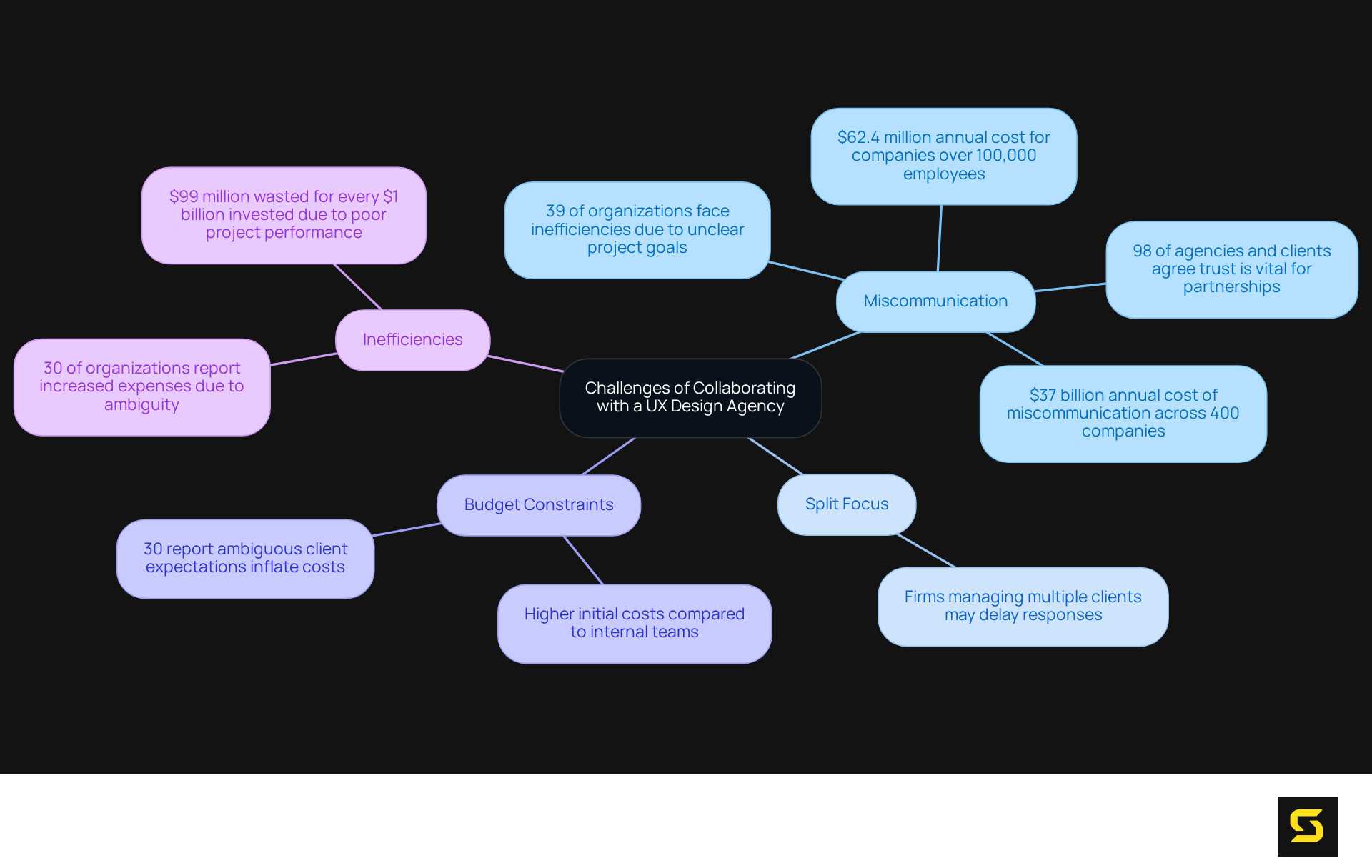
Benefits of an In-House Design Team
Internal creative teams deliver substantial benefits that significantly enhance the effectiveness of UX development for SaaS products. Their deep understanding of the company's culture, values, and objectives enables them to create solutions that align seamlessly with the brand's identity, resulting in cohesive and relevant experiences for users. This familiarity fosters a strong connection between aesthetics and organizational goals, ensuring that interfaces genuinely reflect the company's mission.
Furthermore, internal teams facilitate rapid communication and collaboration, which accelerates decision-making and iteration processes. This agility is vital in fast-paced environments where swift adaptations are often necessary. The ability to quickly respond to feedback and implement adjustments allows for a more flexible approach, ultimately boosting client satisfaction.
In addition, having a dedicated in-house team encourages the continuous integration of user feedback, ensuring that designs evolve in accordance with user needs and preferences. This iterative process not only enhances the product but also nurtures a culture of innovation within the organization.
Moreover, internal teams can conduct scenario planning and impact analysis using advanced technology, which aids in managing software complexity—an essential consideration given that, on average, every enterprise has 4.3 orphaned apps and 7.6 duplicate apps. This capability enables more informed decision-making and strategic alignment.
Ultimately, internal teams instill a strong sense of ownership and accountability among their members. This commitment leads to higher quality outcomes and a more engaged approach to the creation process, as team members are directly aligned with the company's success. While the initial investment in establishing an in-house team may appear significant, it is crucial to recognize that these teams yield substantial long-term cost savings compared to external consultants. Overall, the combination of cultural alignment, enhanced communication, and a focus on user feedback positions internal creative teams as invaluable assets for SaaS companies aiming to collaborate with a user experience design agency to deliver exceptional user experiences.
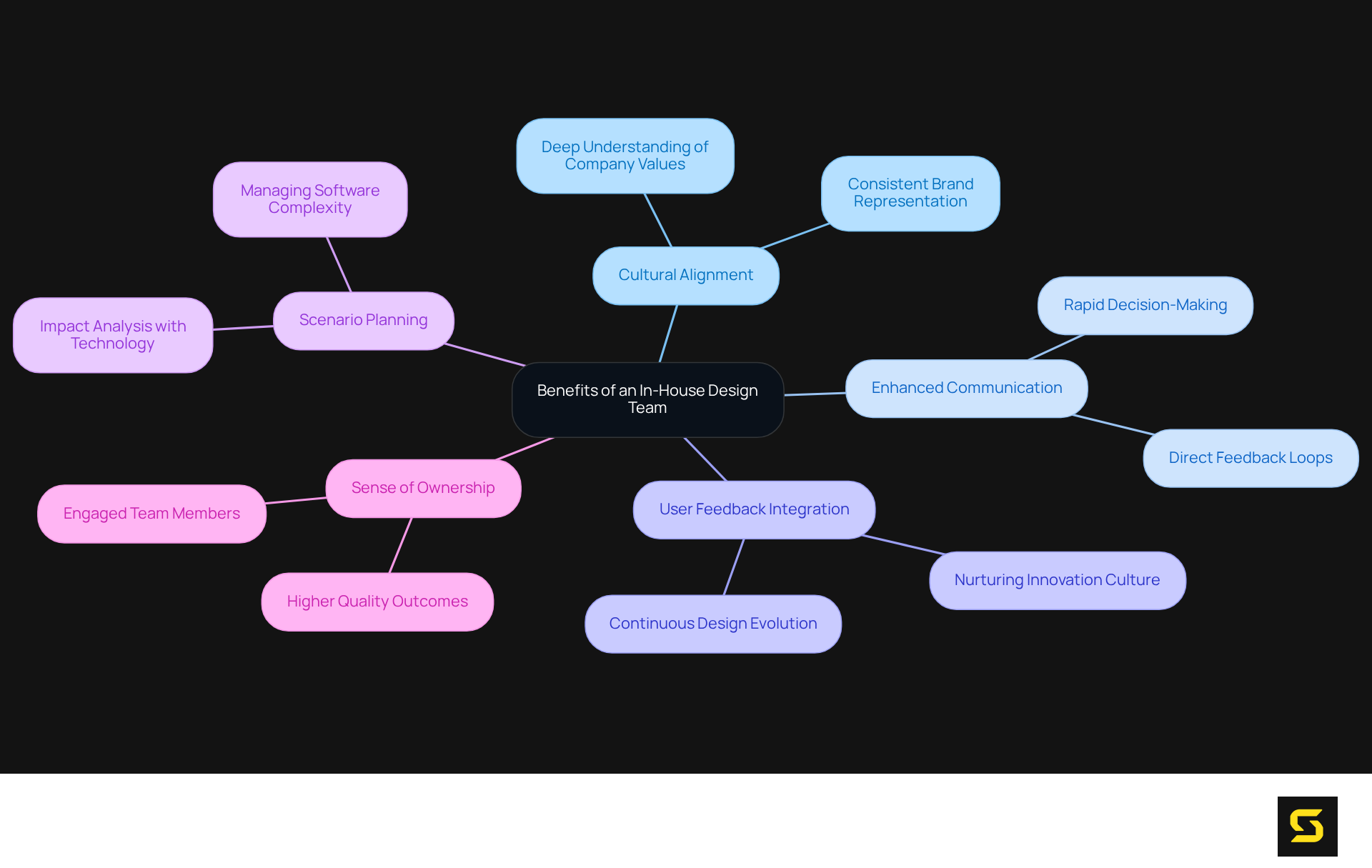
Drawbacks of In-House Design Teams
In-house design groups, while advantageous, face several notable limitations that can impede their overall efficiency. A primary concern is the potential for creativity stagnation; these groups often become too entrenched in established practices and company culture, stifling fresh ideas and innovative thinking. Notably, 50% of creative leaders with over 10 years of experience assert that their groups are understaffed, exacerbating this issue by restricting the variety of viewpoints essential for fostering creativity.
Cost is another critical factor to consider. Maintaining an in-house group entails ongoing expenses such as salaries, benefits, and overhead, which can be particularly burdensome for startups. In-house content creation can incur higher costs due to these factors, with the cumulative expenses of hiring and training often exceeding those of engaging a design agency. This is especially true when specialized skills—such as SEO, graphic design, or video production—are required and may be lacking within internal teams.
Resource constraints further complicate the situation. Smaller internal groups frequently juggle multiple projects, leading to burnout and decreased productivity. The relentless pressure to create content can further exacerbate this issue, resulting in a decline in overall team morale and output. This struggle is intensified by the necessity for ongoing training to keep pace with rapidly changing trends and technologies, imposing additional pressure on already constrained resources. Consequently, companies must carefully weigh these challenges against the advantages of internal creation to identify the most effective strategy for their requirements.
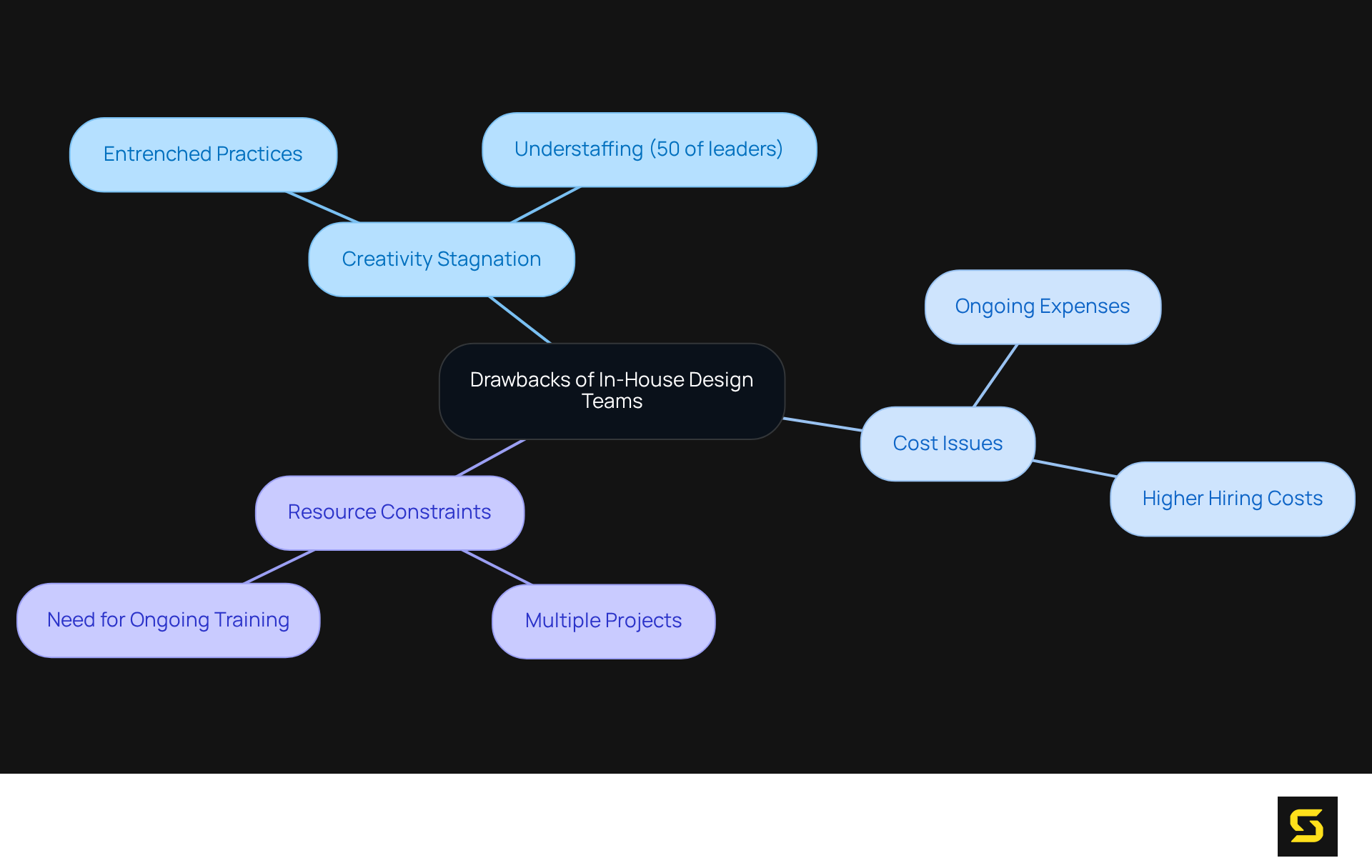
Making the Right Choice for Your SaaS Product
Selecting between a user experience design agency and an in-house design team is a critical decision influenced by several factors, including budget, project scope, and long-term objectives. Companies with limited resources or those requiring specialized expertise often find that collaborating with a user experience design agency offers significant advantages. This approach not only provides flexibility but also grants access to a broader skill set.
For instance, the NWORX redesign, which addressed negative feedback, exemplifies how agency collaboration can effectively enhance client satisfaction through targeted improvements. On the other hand, organizations that prioritize brand alignment and need ongoing design support may discover that an internal team is more suitable. However, maintaining an in-house team can lead to substantial long-term expenses, particularly if project workloads fluctuate.
Therefore, it is essential to evaluate the specific requirements of the SaaS product, considering demographics, project timelines, and the desired level of collaboration. By meticulously weighing the advantages and challenges of each approach, companies can make informed decisions that align with their strategic objectives and significantly enhance their overall user experience through a user experience design agency.
Furthermore, investing in UX is not merely beneficial; it is crucial, as effective UX can double conversion rates, reaching up to 400%. This statistic underscores the financial advantages of adopting a user-centric approach.
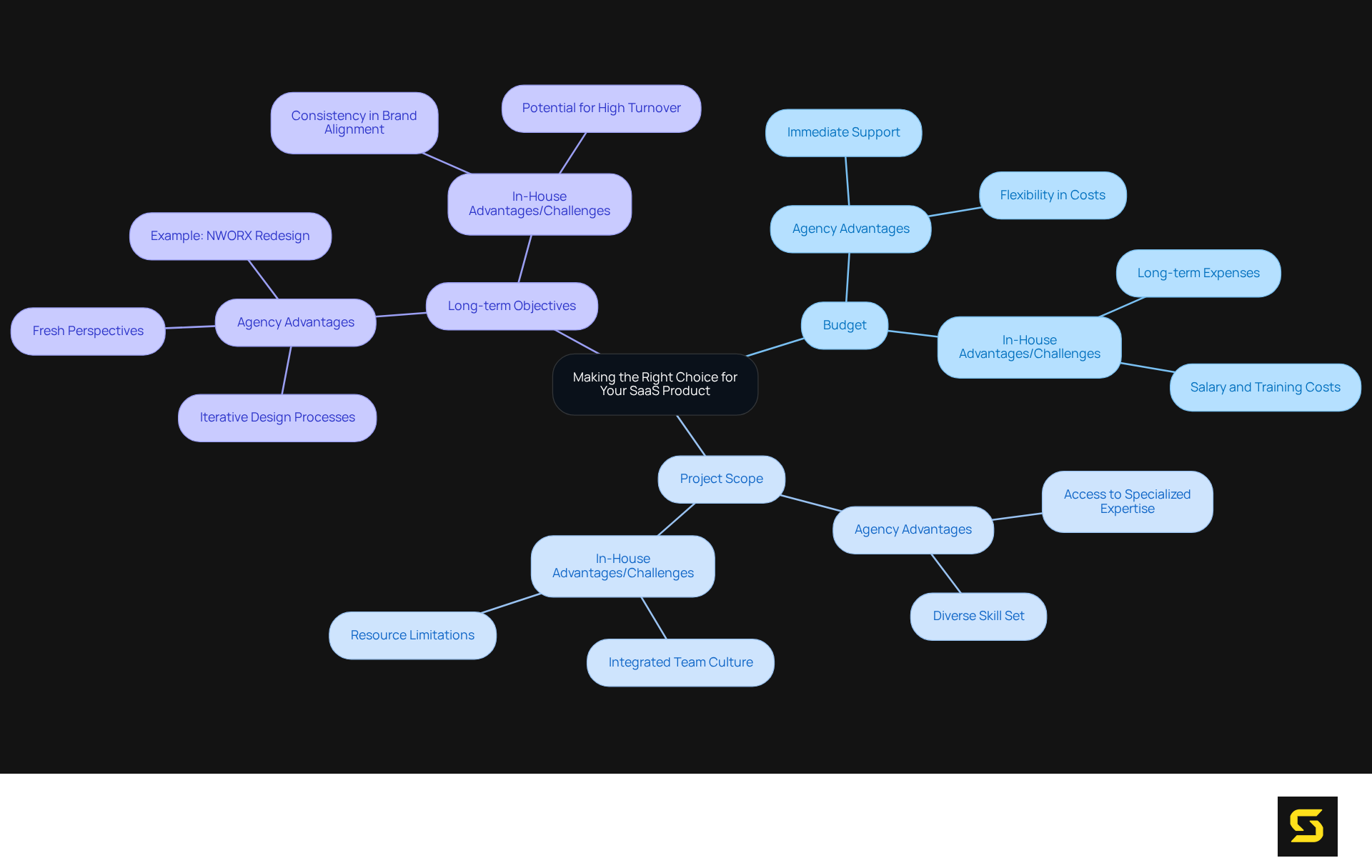
Conclusion
Choosing between a user experience design agency and an in-house team is a pivotal decision for SaaS companies, significantly influencing product success and customer satisfaction. Each option presents unique advantages and challenges; understanding these can help organizations align their UX strategies with broader business objectives.
User experience design plays a critical role in enhancing client retention and satisfaction. User experience design agencies offer specialized expertise, innovative solutions, and scalability. In contrast, in-house teams provide deep brand alignment, rapid communication, and a strong sense of ownership. However, both approaches come with challenges, such as potential miscommunication with agencies and resource constraints within internal teams.
Ultimately, the decision should be guided by specific project needs, budget considerations, and long-term goals. By carefully evaluating these factors, SaaS companies can make informed choices that enhance user experience and drive overall business growth. Investing in effective UX design is not merely a strategic advantage; it is essential for thriving in a competitive market. Embracing a user-centric approach can lead to remarkable improvements in conversion rates and customer loyalty, reinforcing the importance of thoughtful decision-making in UX design strategies.
Frequently Asked Questions
What is the role of a user experience design agency?
A user experience design agency enhances satisfaction by improving usability, accessibility, and enjoyment of interactions between individuals and products. It focuses on understanding user needs and behaviors to develop intuitive and engaging experiences.
How does user experience design impact SaaS companies?
Effective user experience design strategies can significantly influence client retention and satisfaction in SaaS companies. Organizations using scalable SaaS infrastructure have reported 28% fewer performance-related complaints, highlighting the importance of effective UX on operational efficiency.
Why is it necessary for SaaS companies to invest in a user experience design agency?
Investing in a user experience design agency is essential for SaaS companies to thrive in a competitive market. Effective UX strategies can improve satisfaction and retention by streamlining onboarding processes and incorporating personalized features.
What are the key principles that a user experience design agency should prioritize?
A user experience design agency should prioritize architectural principles that foster stronger client relationships, enhance loyalty, and achieve sustained success. Continuous optimization based on user feedback is also crucial for maintaining relevance and engagement.
What advantages do UX design agencies offer to SaaS companies?
UX design agencies provide diverse teams with substantial experience, which fosters creative solutions and innovation. They also offer scalability, allowing resources to adjust to project demands, and leverage cutting-edge tools and methodologies to ensure high-quality outputs.
How can a well-designed user interface benefit a company?
A well-designed user interface can boost conversion rates by as much as 200%, demonstrating the tangible benefits of investing in expert creative services.
What challenges might companies face when engaging a UX design agency?
Companies may encounter challenges such as timezone differences, language barriers, and risks related to intellectual property and data security when working with a UX design agency.
How does outsourcing UX development improve operational efficiency?
By outsourcing UX development, organizations can focus their internal resources on core business functions, leading to enhanced overall operational efficiency.





